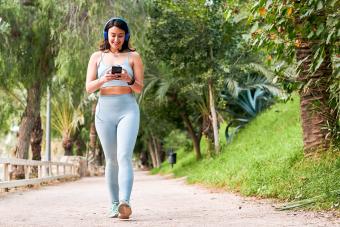
Walking is one of the easiest forms of exercise to build and maintain fitness. Even if you are extremely out of shape, you can slowly begin building a fitness routine centered around walking. It requires minimal equipment and is easy to incorporate into your daily lifestyle, making it the ideal fitness activity for people at all levels of fitness.
Building a Walking Program
Walking is easily tailored to all levels of fitness. If you are quite sedentary, you will need to start much more slowly than if you are already in pretty good shape. Like other forms of activity, walking helps build cardiovascular endurance, as well as muscular endurance.
Increasing the Effectiveness
When planning your walking program to build fitness, you can change three variables to increase the effectiveness of your workout: frequency, intensity, and duration.
- Frequency refers to how often you walk.
- Intensity refers to how difficult the workout is. You can vary your intensity via speed or terrain. In other words, to make a walking workout more intense, you can walk faster, spend more time walking on hills, or a combination of the two.
- Duration refers to how long you walk.
Eight-Week Walking Program
A good walking program takes all three variables into account. Use the following table to begin to tailor your own personal walking program. Once you've reached the end of the eight weeks for your activity level, you can move up to the next level and begin that program. Once you reach advanced, follow the provided tips for increasing the intensity of your workouts.
| Beginner/Sedentary | Intermediate/Mildly Active | Advanced/Very Active | |
| Week 1 |
Frequency: 2 times Intensity: Slow pace, mostly flat Duration: 10 minutes |
Frequency: 3 times Intensity: Moderate pace, moderate hills Duration: 45 minutes |
Frequency: 5 times Intensity: Quick pace, mostly hilly Duration: 60 minutes |
| Week 2 |
Frequency: 2 times Intensity: Slightly faster, mostly flat Duration: 15 minutes |
Frequency: 4 times Intensity: Same as last week Duration: 45 minutes |
To continue to build intensity, opt for intervals. Walk 5 minutes at your normal pace, and then walk 2 minutes at a very fast race walk. Repeat in cycles for 60 minutes. You can also continue to build intensity by walking hill intervals. Walk at a quick pace for 4-5 minutes on the flat, and then walk at the same pace up a steep hill or on stairs. Complete in cycles for the 60 minute duration. |
| Week 3 |
Frequency: 3 times Intensity: Same as previous, add small hills Duration: 15 minutes |
Frequency: 4 times Intensity: Pick up the pace a bit, incorporate higher grade hills Duration: 45 minutes |
|
| Week 4 |
Frequency: 3 times Intensity: Slightly faster, small hills Duration: 25 minutes |
Frequency: 4 times Intensity: Same as last week Duration: 50 minutes |
|
| Week 5 |
Frequency: 3 times Intensity: Same as last week Duration: 30 minutes |
Frequency: 5 times Intensity: Same as last week Duration: 50 minutes |
|
| Week 6 |
Frequency: 3 times Intensity: Slightly faster, steeper grade hills Duration: 30 minutes |
Frequency: 5 times Intensity: Quicken your pace, stay on same grade hills Duration: 50 minutes |
|
| Week 7 |
Frequency: 3 times Intensity: Same as last week Duration: 40 minutes |
Frequency: 5 times Intensity: Same as last week Duration: 55 minutes |
|
| Week 8 |
Frequency: 3 times Intensity: Moderate pace, moderate hills Duration: 40 minutes |
Frequency: 5 times Intensity: Same pace, increase length and grade of hills Duration: 55 minutes |
Warm Up and Cool Down
Walking, like every other physical activity, requires a warm-up and cool-down. Likewise, you should always follow your cool down with stretching to maintain muscle flexibility and range of motion. To warm up, walk for five minutes at a slower pace. To cool down, gradually slow your pace for about five minutes.
Keeping Track
It may help maintain routine to track your program. Simple entries listing the date, duration, and intensity will suffice. You can also use a pedometer to track mileage, which can give you a good idea of the speed you are walking so you can adjust your intensity as needed.
Cautions and Contraindications
Before beginning any exercise routine, check with your doctor to ensure you are in good health. A walking routine may be contraindicated if you have any of the following conditions:
- Foot, ankle, knee, leg, or hip problems
- Deep vein thrombosis in the lower extremity
- Acute or severe back pain
If you have serious disease, such as heart disease, diabetes, or cancer always talk with your doctor before beginning a program.
Equipment
The great thing about walking is that you don't need a lot of equipment. However, you must have is a pair of good walking shoes. Visit your local sporting goods store to be fitted for a pair of shoes especially designed for walking. If you walk several times per week, you may want to have a few pairs of shoes you wear in rotation in order to allow the other pair time to dry. This makes for more comfortable walking and protects your feet.
Other equipment you may need includes the following:
- Walking clothes: A leisurely stroll doesn't necessarily call for athletic clothing, but if you want to get serious about walking, then you will want to get clothing that is conducive to exercise. Clothes designed for walking are comfortable and allow for airflow so you aren't drenched in sweat by the time your walk is over. Find clothing in fabrics that wick away sweat and minimize chafing.
- Socks: When you walk great distances and your feet sweat, socks begin to make a difference. Cotton socks are just about the worst kind for walking long distances, because they absorb sweat and can cause blisters. Instead, look for technical fabrics designed especially for walking that wick moisture and minimize friction.
- Music player: Whether you choose an MP3 player or a small portable radio, you may find that walking is a lot more fun when you do it while listening to your favorite music. Make sure you follow local laws about wearing music devices while walking; some places - like military installations - do not allow pedestrians to wear headphones.
- Walking/jogging stroller: Why not bring your kids along on your walks and show them how much fun it can be to exercise while enjoying the outdoors? Be sure to test drive plenty of different walking strollers before making your purchase because pushing a difficult stroller can ruin walks quickly.
Ready to Walk
Even if you don't have any equipment, you can get started walking today. Take a ten-minute stroll outdoors, and then do it again in a few days. If you keep it up regularly and gradually increase the time you spend walking, you'll be well on your way to getting fit.







